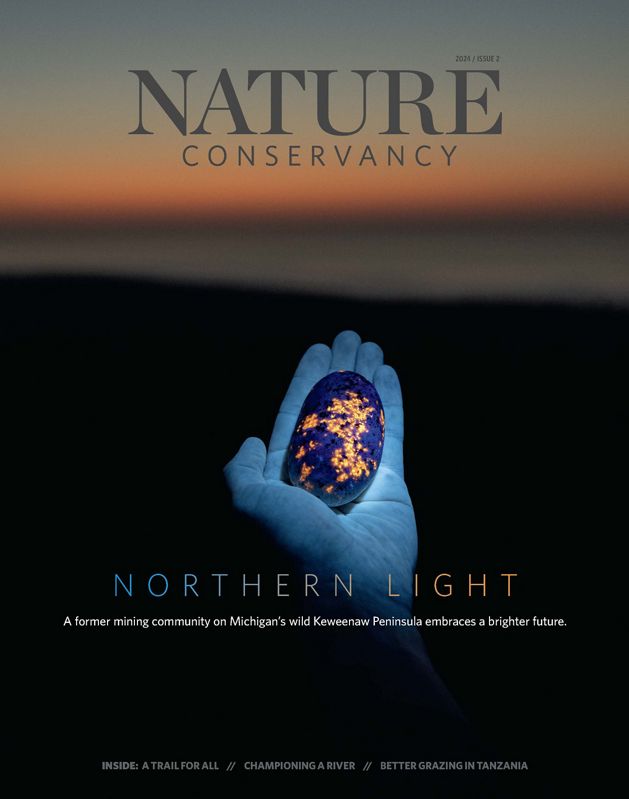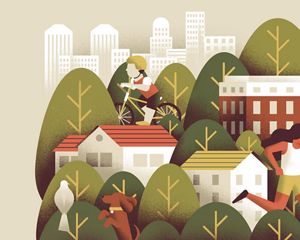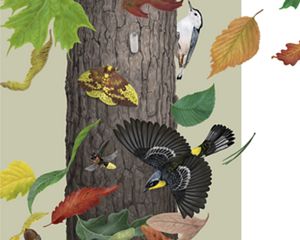
Turning the Tide
On Long Island, a group of Shinnecock women are nursing a bay back to health and, in the process, reclaiming traditions.
Photographs by Katie Orlinsky | Text by Claudia Geib | Issue 1, 2025
Danielle Hopson Begun stands waist-deep in the waveless expanse of Long Island’s Shinnecock Bay. She reaches into the water and lifts out a heavy rope, which drips with the amber and butterscotch-colored fronds of a marine plant called sugar kelp. It’s early June, and over the past eight months this kelp, anchored here, has grown from millimeter-long seedlings into foot-long golden ribbons, absorbing nitrogen and carbon from the water in the process.
Tended by Hopson Begun and four other women from the Shinnecock Indian Nation, these lines are part of the first Indigenous-owned kelp farm on the U.S. East Coast. The kelp is harvested each year and sold locally as a natural fertilizer. But for these women, who have formed a nonprofit organization called Shinnecock Kelp Farmers, it has become something more than a crop: It is one piece of a multifront effort to reassert ancestral ties to the lands and waters their community has stewarded for thousands of years.
Today, though, Shinnecock Bay is drastically different from the waters their ancestors once harvested wild kelp from. It’s more polluted, and the waters have grown warmer and more acidic. And almost every year since starting the farm in 2020, Hopson Begun and her partners have found their lines coated in an alga that suffocates and kills baby kelp. It significantly reduced part of their harvests—until now.
To combat the algae, the kelp farmers have turned to cutting-edge science and technological solutions—supported by a grant from The Nature Conservancy and industry expertise from aquaculture nonprofit GreenWave—to supplement their long connection to the bay.
“There is this traditional knowledge that we have—of how the seaweed grows in the bay, and how to nurture it and prepare it for the work that it has to do,” says Tela Troge, one of the group’s founders. If the Shinnecock Kelp Farmers can successfully grow kelp in the bay—weaving this ancestral understanding with modern science—the plant stands to help restore an ancient link to a cultural practice, while perhaps helping stem the rising tide of pollution that has invaded these waters since the arrival of colonialism.
Among the challenges of farming kelp is simply finding the time. The kelp farmers and their friends and families—mothers, lawyers, counselors, activists—live and work in the communities of the greater Long Island and New York City area. Today about half of the nearly 1,600 enrolled members of the Shinnecock Indian Nation live on a 900-acre property on the eastern edge of Shinnecock Bay—a property surrounded by wealthy Hamptons enclaves and just a barrier island away from the Atlantic Ocean.
Life here has always been intertwined with water. For at least 10,000 years, the “People of the Stony Shore” gathered fish, mussels, scallops and clams, and cultivated oyster gardens along a vast stretch of land and waters on and around what is now called Long Island. Skilled seafarers, they relied on the Shinnecock and Peconic Bays—both local inlets—as well as the open sea. They hunted whales and exchanged white and purple wampumpeag beads they carved from the shells of hard clams, or quahog. These beads, known as wampum, remain an important touchstone for the Shinnecock, who continue to carve them as jewelry and cultural symbols.
When Europeans arrived in the Northeast in the 1600s, they brought diseases that decimated the Shinnecock and their neighbors, razed forests to sow farms and claimed burial grounds to build towns. Over time the Shinnecock Indian Nation lost access to most of their historic hunting and fishing grounds, retaining a territory of about 1,000 acres, including the 900-acre reservation. With the spread of new people, the waters the Shinnecock relied on changed, too.
Shinnecock Bay, in particular, suffered. The bay spans 9,000 acres, separated from the Atlantic Ocean to the south by a narrow barrier island. Warm and shallow, with an average depth of only about 6 feet, the bay’s connection to the sea has shifted over the centuries as storms alternately carved and filled in cuts through the island. A powerful 1938 hurricane created Shinnecock Inlet, a permanent opening to the Atlantic. Yet, still largely landlocked, the bay’s waters concentrated high levels of nitrogen, which seeped through the ground from cesspools and septic systems as homes and towns sprung up along its shores.
By the 1980s, annual nitrogen-fed algal blooms turned the water “brown like a cup of coffee,” says Stony Brook University researcher Ellen Pikitch, one of the co-founders of the university’s Shinnecock Bay Restoration Program. These “brown tides” clouded the water, blocking sunlight from reaching eelgrass, killing fish and destroying shellfish habitat. “There’s been kind of a downward spiral going on for years, and the brown tide was one of the first big signals that something really bad [was] happening,” Pikitch says.
As a result, by the mid-2000s the marine life that the Shinnecock people had once relied on was nearly gone. Oyster reefs vanished. Between the 1970s and 2011, the commercial fishery for quahogs, the clams used for Shinnecock wampum and food, collapsed by more than 99%.
At the same time, members of the Shinnecock Indian Nation had been fighting to assert their ancestral land and water claims. In 2019, an ocean-farming nonprofit called GreenWave reached out to members of the Nation. Inspired by a PBS documentary about the Shinnecock people’s long battle against Southampton’s development, one of the group’s staffers wanted to know if members of the Nation would consider working with GreenWave on a kelp farm.
The proposal captured the interest of the future Shinnecock Kelp Farmers for multiple reasons. They knew that, historically, the Shinnecock harvested seaweed for home insulation, food and medicine, and that kelp could absorb nitrogen and carbon into its tissues. When harvested and dried for garden fertilizer and used in place of traditional fertilizers, kelp offered a way to pull excess nutrients from the bay—a way to fight back against the pollution in area waters and to reclaim a stake in managing the waters they stewarded for generations.
The Sisters of St. Joseph, a Catholic religious order, joined the collaboration by providing water access from their community center along Shinnecock Bay. In 2020, five Shinnecock women—Danielle Hopson Begun, Donna Collins-Smith, Rebecca Genia, Tela Troge and her mother, Darlene Troge—took up waders and began the work of nursing kelp to life.
“For about 400 years, the colonists, the settlers, the local town government have had control of the water, and it’s just become polluted,” Tela Troge says. “It was time to restore Indigenous stewardship.”
The Kelp Harvest





Harvesting sugar kelp is, by nature, an act of cooperation. As Hopson Begun moves along the lines of mature kelp, she stuffs the lines into purple mesh bags that quickly grow heavy with fronds. When the bag is full, she passes it to Collins-Smith, who in turn transfers it into the waiting hands of another helper who will wade with it to shore. With many hands, the work takes only about two hours this June morning. Soon, the beach is piled high with mesh bags. Sacks of kelp spill off the rocky seawall and around the stairs climbing the bluff, waiting to be laid out in the sun to dry.
The kelp harvest has not always been so successful: Baby kelp starts small, and that makes it vulnerable. Each fall, the kelp farmers dive in local waters to find naturally occurring mature sugar kelp. They collect its reproductive tissues, which they then encourage to multiply in a hatchery they have established on the Sisters of St. Joseph property. But warming waters have made local kelp harder to find, delaying the “planting” of the kelp lines until December or even January. By that time of year, “slip gut”—a seasonal algae that occurs in these waters—has matured enough that it can easily grow on and over the baby kelp, choking out the light it needs to grow.
After two challenging seasons, a new contributor offered help from a different angle. In the summer of 2021, Hopson Begun met with The Nature Conservancy’s Long Island Preserve Director Kevin Munroe, which led to a new partnership. With the help of a $75,000 grant from TNC in 2023, the kelp farmers updated their hatchery with state-of-the-art water-purification equipment. The grant also helped connect them with TNC staff and partners on the Pacific Coast.
The hatchery expansion lets the kelp farmers purify their own water on-site, a necessity for growing kelp. It also enables a new method of kelp propagation that allows the kelp farmers to hurdle many of the challenges of previous years, including slip gut algae.
Growing kelp requires mimicking the kelp’s entire reproductive cycle in the hatchery. Using temperature, light and purified seawater, the kelp farmers induce wild reproductive kelp tissue (known as sorus tissue) to release spores that grow through several life stages to eventually become microscopic kelp plants called sporophytes. The process takes weeks.
For the 2024 season, the farmers tried out an alternative method drawn from research by scientists at the University of Connecticut and Woods Hole Oceanographic. They started with gametophytes—essentially a more mature kelp seed grown from previously harvested sorus tissue and held in a culture until ready to be used. They nurtured these gametophytes in a similar way, but saved weeks in the process.
The new method allowed the kelp farmers to place their lines in the bay earlier for the 2024 harvest season, setting up the baby kelp to outcompete slip gut when it arrived.
Quote: Tela Troge
“ For about 400 years the colonists, the settlers, the local town government have had control of the water, and it’s just become polluted. It was time to restore Indigenous stewardship.”
Small advantages like this mean everything these days, as the kelp farmers balance improvements they’re seeing in the bay with a deluge of other environmental issues.
Shinnecock Bay is warming: The annual sea surface temperature in the region has trended upward year after year for the past half century, and is expected to rise another 4 to 8°F over the century to come. And over the past 200 years, ocean waters worldwide have become 30% more acidic, as carbon dioxide dissolves into the water and transforms into carbonic acid. One result has been more brittle shells for creatures like clams. The Shinnecock Kelp Farmers have seen this drop in pH firsthand: For many years, any quahog shells they could find were brittle and difficult to carve.
At the same time the Shinnecock Kelp Farmers and their Nation have tried to reassert ancestral legal claims to the lands along these waters. As a seafaring Nation that once occupied much of Long Island, the tribe considers the area’s waters to be unceded and stolen, and sued the state of New York in 2005 in an attempt to reclaim about 3,600 acres of ancestral lands in Shinnecock Hills—now developed into the wealthy Hamptons. In 2016, the Supreme Court declined to hear the case.
Long Island Clean Water News
Barring that recognition, the Shinnecock Kelp Farmers have advocated for co-management of area waters as they’re leased out for aquaculture. And they’ve joined The Nature Conservancy in its long campaign advocating to expand sewers and replace polluting septic systems with clean water alternatives. That effort made major progress in November 2024 when Suffolk County voted to increase the local sales tax to raise $4.2 billion to pay for these types of upgrades and $1.9 billion for conserving lands to protect area waters.
There is evidence that well-managed waters could result in real change. Stony Brook University’s bay restoration team has documented multiple improvements: Between 2012 and 2021, for instance, the organization planted more than 5 million clams in two “sanctuaries” in western Shinnecock Bay, and established four oyster reefs around the bay. In response, brown tides and other algal blooms have largely disappeared, water quality improved, and seagrass beds expanded on the western side of the bay. Pikitch, whose specialty is fishes and their ecosystems, has documented a fourfold increase bay-wide in the abundance of forage fish, like anchovies and menhaden, which form the base of the food chain.
The Shinnecock Kelp Farmers have seen changes that suggest their kelp farm, too, is improving the waters around it. For one, it seems to be a sanctuary for wildlife: Shorebirds and diving ducks chase schools of fish around the kelp lines, while oysters, clams and mussels grow on anything they can find. Hopson Begun has even startled a dogfish (a small shark) hunting among the kelp. Over just four years, the kelp farmers have begun to once again find quahog shells sturdy enough to make wampum.
“We initially thought that all the changes that we were going to experience would be microscopic, in terms of the amount of carbon that we could sequester or the amount of [nitrogen] that we could remove,” says Tela Troge. “Speaking for myself, I didn’t think that we would see such immediate, impactful, observable changes.”
On that bright June day in 2024, as the kelp farmers gathered at the Sisters of St. Joseph’s, it marked the first harvest of kelp raised in their updated hatchery using the new method. The day ended with the villa’s lawn covered in a layer of glistening amber leaves, drying on window screens and mesh nets. The harvest weighed in at 1,200 pounds; after drying, that yielded hundreds of jars of soil amendment to be sold at local farmers markets.
Throughout the day, grandmothers and aunts sought the shade of the front porch, setting out food, swapping stories and sharing Shinnecock lore. Spouses and friends helped haul kelp-packed mesh bags up the long stretch of stairs and lay the seaweed out to dry on the Sisters’ front lawn. Tela Troge’s young son scampered underfoot, picking up shells and smooth stones and pressing these little gifts into the helpers’ hands.
This is what the Shinnecock Kelp Farmers have become: Though the five women who founded the group still form its core, it’s supported by a network of people who want to see their work succeed. Just as Shinnecock Bay’s waters rely on the health of oysters and eelgrass, scallops and seabirds, the strength of the collective relies on the strength of its support. And the Shinnecock Kelp Farmers, too, have become part of this support network for others. They’ve shared seeds from their expanded hatchery with other kelp farmers from nearby Montauk and Jamaica Bay. And they share knowledge they’ve gained as well as their nonextractive approach with interested parties around the world.
The Shinnecock Kelp Farmers plan to continue expanding and, in the coming years, hope to co-culture oysters and scallops alongside their kelp lines, to further increase the farm’s water-cleaning capacity, Hopson Begun says.
And they want to help more kelp farms come online, too: “We can’t do it alone,” Hopson Begun says.
They see this network as not only helping to nourish ocean ecosystems but also sustaining the people working to preserve them, in the face of overlapping environmental issues.
“If you think about everything, the whole ocean, that’s a lot,” Tela Troge says. “But what can we do where we live, right here, to address the problem here, and to share that knowledge? That is possible. And if every single community takes this community-based approach, then you start seeing regional improvement, and then you start seeing national improvement, and then you start seeing overall ocean health improvement.”
About the Creators
Claudia Geib is a science journalist who focuses primarily on marine, environmental and conservation science. She is also the producer of the science and food podcast Gastropod.
Katie Orlinsky is a photographer whose work has appeared in National Geographic, The New Yorker and other publications. Since 2014, she has undertaken a long-term project documenting the human stories of climate change across the Arctic.

Magazine Stories in Your Inbox
Sign up for the Nature News email and receive conservation stories each month.











